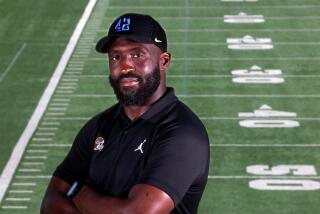Each New Day Is a Bonus for Hawaii Football Coach
- Share via
He should not have been working at his Honolulu office.
He should not have been available for comment.
He should not have been in position to pick up the receiver and return a phone message.
June Jones, by all rights, should be dead.
They should have notified next of kin Feb. 22, signed the certificate and made arrangements.
The stadium would, by now, be named in Jones’ honor, with George Lumpkin, his top assistant, reluctantly ascending to become the next Hawaii football coach.
What a lump-throated dirge the 2001 season would have become, Jones’ face gracing the media guide cover--his image honed and stitched onto uniform arm patches.
Forty-eight years old.
Damn shame.
Left behind a wife, Diane, and four children, the youngest, 7-year-old June IV, who keeps waiting for Dad to walk in the front door.
We are thrilled to report that none of these somber scenes had to be played out.
Hawaii opens the season Sept. 8 against Montana on Maui and June, by Jones, will be back on the headsets.
He recently, if not very gingerly, returned to work, never happier to punch a clock.
“From what the doctors tell me, I’m not supposed to be here,” he says from Honolulu.
He recalls nothing of events that led to the morning crash last February near Honolulu International Airport.
Jones was returning from a breakfast meeting when his car veered off the road and slammed into a concrete pillar.
Jones guesses he fell asleep, although one witness reported that Jones had unfastened his seat belt and was reaching for something in the passenger seat shortly before the crash.
Jones hit the post with such force that the two-iron in his golf bag, stashed beside him in the front passenger seat, pierced the steering column like an arrow through an apple.
June was busting out all over.
He lay bleeding and unconscious.
Doctors had to saw through 12 ribs just to get at the damage: ruptured liver, punctured lung.
It took 100 stitches to close a head wound.
After four hours of surgery, Jones’ blood pressure remained dangerously low--for good reason.
Turned out his aorta, the great arterial trunk that distributes blood to the body, had been three-quarters torn.
Doctors told Jones the rupture should have killed him in 15 to 20 minutes.
“I lived for four hours,” Jones says. “The doctor said that it just goes against all odds. He said you’re one in 10 million people to survive that.”
Jones spent two weeks in a coma. His first instinct after waking was to get out of his hospital bed.
“I was a pro athlete,” the former Atlanta Falcon quarterback says. “You could never be hurt, or you were going to lose your job.”
Jones wouldn’t get up for a long time.
“I relived everything while I was wasting away in the hospital for 30 days,” he says. “I rethought everything. I did all that kind of stuff, wondering why.”
Four months later, Jones still aches, head to toe. He ambles slowly through light workdays and has yet to regain full strength in his legs.
But he is back. To prove it, he recently rode his Harley Davidson around Oahu.
“Even that hurt,” he says, “but I felt like when I did that I said, ‘There, I’m over it.’ ”
He hasn’t gotten over the impact his accident had on the community.
There was other important news in Hawaii at the time of Jones’ crash, namely the investigation of a Navy submarine collision with a Japanese training trawler.
Yet, Jones’ lone-occupant crash pushed all other news aside.
Hawaii, a provincial and political island chain, has embraced Jones as no other outsider coach. He was born in Oregon but played quarterback at Hawaii in 1973-74 before embarking on a pro career as a player and coach.
Jones turned down a chance to coach the San Diego Chargers to return to Hawaii in 1999, inheriting a team on an 18-game losing streak. His first season, deploying 22 starters from an 0-12 squad, Jones led Hawaii to a 9-4 record, the biggest turnaround in NCAA football history.
Last year’s team slipped to 3-9, but Jones remains beloved, credited with helping to restore confidence to a recession-ridden state.
“The people here have accepted me as one of theirs, and when they do that, it’s like blood,” Jones says. “The aloha spirit has definitely shown throughout this whole ordeal.”
As if a witness to his own memorial, Jones has watched television replays of reaction to his accident.
“I never realized that me, just me, could impact so many people,” he says.
Jones’ recovery has spurned a revival. More than 100 Hawaii players are showing up daily for voluntary summer workouts.
“They just seem more focused,” Jones says. “I don’t know if it was because of the wreck, whether it brought everybody closer together.”
Jones can’t wait for fall camp and the chance to turn 3-9 to 9-3.
He has a terrific young quarterback in Timmy Chang, a talented receiver in Ashley Lelie, and a new outlook.
“I think the accident has made me want to experience more happiness,” he says, “because you don’t know how long you’re going to be here.”
Football is a numbers game.
Life too.
“It just wasn’t my number to go,” Jones says. “I feel lucky I didn’t, so I’m going to enjoy the reprieve that I have.”
More to Read
Go beyond the scoreboard
Get the latest on L.A.'s teams in the daily Sports Report newsletter.
You may occasionally receive promotional content from the Los Angeles Times.











